
Symptoms of a clogged catalytic converter
Content
- Catalyst, why is it installed, device and purpose
- Reasons for a clogged catalyst
- Features of clogging the catalyst on different cars
- What are the symptoms of a clogged catalyst?
- How to check - clogged catalyst or not
- How to check the catalyst for clogging without removing
- Consequences of a clogged catalyst
- How does a clogged catalyst affect engine performance?
- Oil consumption with clogged catalyst
- What if the catalyst is clogged?
- How to Repair a Clogged Catalyst
- Catalytic converter replacement
- Consequences if the catalyst is not repaired
- Can you drive with a clogged catalytic converter?
- Is it necessary to carry out maintenance of the catalyst in a timely manner?
- Related videos
- Questions and answers:
Every modern car is equipped with a catalytic converter. This element of the exhaust system allows harmful substances to be removed from the exhaust gases. More precisely, this detail neutralizes them, splitting them into harmless ones. But, despite the benefits, the catalyst requires the proper functioning of various systems in the car. For example, the exact composition of the air / fuel mixture is very important for the processes taking place in the catalyst.
Let's consider how the catalytic converter works, what problems a clogged element of the exhaust system can cause to the driver, why it can clog up. We will also discuss whether a clogged catalyst can be repaired.
Catalyst, why is it installed, device and purpose
Before we consider for what reasons this part can fail, it is necessary to understand how it works. As we have already noticed, a catalyst is a part of the engine exhaust system, and it is installed not only on a gasoline unit, but also on a diesel engine.
The first cars equipped with catalytic converters were produced in the 1970s. Although at that time the development had existed for about twenty years. Like all developments, the catalyst device has been refined over time, thanks to which modern options do an excellent job of their task. And due to the use of additional systems, harmful exhaust gases are effectively neutralized at different engine operating modes.
This element is designed so that during the operation of the power unit, chemical reactions occur in the exhaust system that neutralize harmful substances that appear during the combustion of fuel.
By the way, in order to make the diesel engine exhaust cleaner, a urea injection system is installed in many car models. Read about what it is and how it works. in another review... The photo below shows the catalyst device.

The section shows that this element will always look like a honeycomb. All ceramic catalyst plates are coated with a thin layer of precious metals. These are platinum, iridium, gold, etc. It all depends on what kind of reaction needs to be provided in the device. But more on that later. First of all, this element must be warmed up in order for unburned fuel particles to burn out in this cavity.
The flask is heated by the intake of hot exhaust gases. For this reason, the catalyst is installed in close proximity to the power unit so that the exhaust does not have time to cool down in the cold exhaust system of the car.
In addition to the final afterburning of fuel, a chemical reaction takes place in the device to neutralize poisonous gases. It is provided by the contact of the exhaust molecules with the hot honeycomb surface of the ceramic substrate. The design of the catalytic converter includes:
- Frame. It is made in the form of a bulb, reminiscent of an additional silencer. Only the inner element of this part is different;
- Block carrier. This is a porous ceramic filler made in the form of thin tubes, forming a honeycomb in section. The thinnest layer of precious metal is deposited on the surface of these plates. This part of the catalyst is the main element, since chemical reactions take place in it. The cellular structure allows to increase the contact area of the exhaust gases and the heated metal;
- Heat insulating layer. It is necessary in order to prevent heat exchange between the bulb and the environment. Thanks to this, the device maintains a high temperature even in cold winters.
The catalytic converter inlet and outlet are equipped with lambda probes. In a separate article read about the essence of this sensor and how it works. It should be noted that there are several types of catalysts. They differ from each other by the metal that is deposited on the surface of the cells of the carrier block.
By this parameter, catalysts are divided into:
- Recovery. These catalytic converters use rhodium. This metal, after heating and in contact with exhaust gases, reduces NO gas.xand then converts it. As a result, nitrogen is released from the exhaust pipe into the environment.
- Oxidizing. In such modifications, palladium is now mainly used, as well as platinum. In such catalysts, the oxidation of unburned hydrocarbon compounds is much faster. Due to this, these complex compounds decompose into carbon monoxide and carbon dioxide, and steam is also released.

There are catalysts that use all of these components. They are called three-component (most modern catalysts are of this type). For an effective chemical process, a prerequisite is the temperature of the working environment in the region of 300 degrees. If the system works properly, then under such conditions, about 90% of harmful substances are neutralized. And only a small fraction of toxic gases enters the environment.
The process of reaching operating temperature in each car is different. But catalyst heating can be done faster if:
- Change the composition of the air-fuel mixture to a more enriched one;
- Install the catalyst as close to the exhaust manifold as possible (read about the function of this engine part. here).
Reasons for a clogged catalyst
During the operation of the vehicle, this element will be clogged, and over time it will cease to cope with its task. The honeycomb can become clogged with carbon deposits, the cavity can be deformed or completely destroyed.
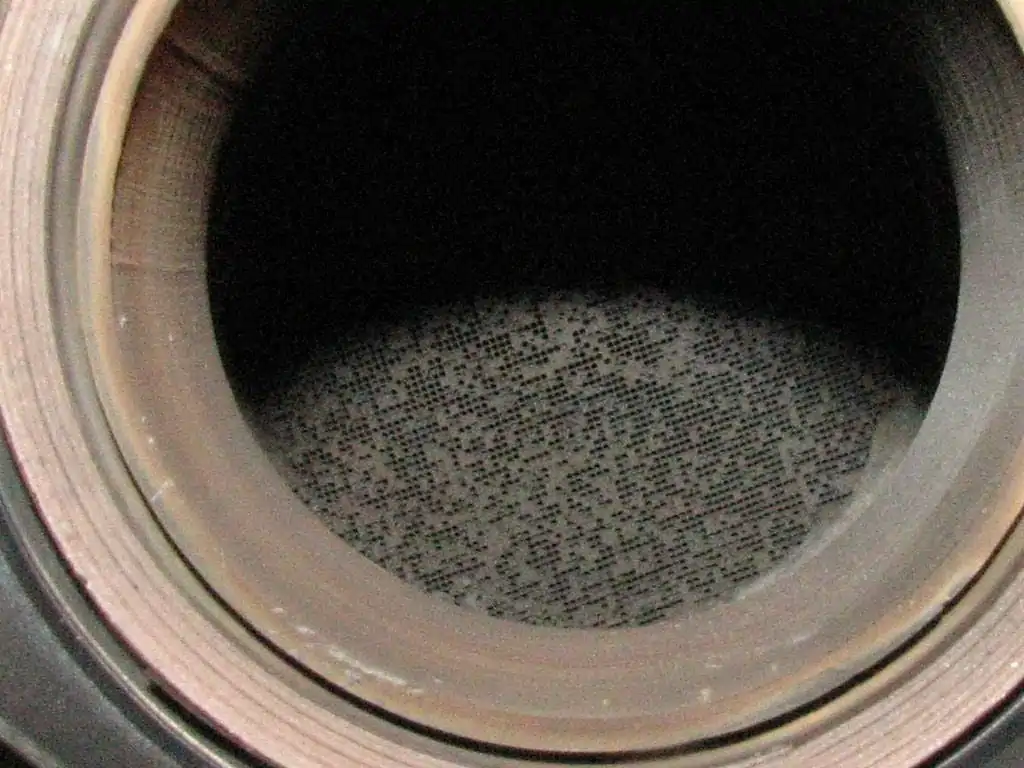
Any malfunction can be caused by the following reasons:
- The driver constantly refills the car with low-quality gasoline or diesel fuel. The fuel may not completely burn out. Residues in large quantities fall on the hot honeycomb, during which they ignite and increase the temperature in the catalyst. In addition to the fact that the released energy is not used in any way, excessive heating of the honeycomb leads to their deformation.
- Clogging of the catalyst honeycomb also occurs with some internal combustion engine malfunctions. For example, oil scraper rings on the pistons are worn out or oil scraper seals in the gas distribution mechanism have lost their properties. As a result, oil enters the cylinder. As a result of its combustion, soot is formed, which the catalyst cannot cope with, since it is not designed to work with soot in the exhaust gases. Very small cells quickly become clogged due to the build-up of burning, and the device breaks down.
- Using a non-original part. In the list of such products, there are often models with too small cells or poor deposition of precious metals. Particular attention should be paid to American products. Vehicles adapted for this market are equipped with quality catalysts, but with a very small cell. The gasoline used in some regions is not of a high quality to ensure a long service life. For the same reason, you should be careful when buying a car from an American auction.
- Leaded gasoline, tetraethyl lead (used to increase octane number gasoline to prevent knocking in the engine) should never be used if the car is equipped with a catalyst. These substances also do not completely burn out during the operation of the power unit, and gradually clog the cells of the neutralizer.
- Destruction of the porous ceramic element due to impacts on the ground while driving over bumps.
- Much less often, but it does occur, catalyst failure can cause prolonged operation of a faulty power unit.
Regardless of what reason reduces the catalyst resource, you need to check the condition of this element of the exhaust system. But before we look at how to determine if a catalyst is faulty, let's discuss what symptoms indicate a problem with it.
Features of clogging the catalyst on different cars
Regardless of the make and model of the car, if it uses an exhaust system with a catalytic converter, then if it is clogged, the engine will not work correctly. For example, on models of the VAZ family, this problem is often accompanied by a sound from under the car, as if stones appeared in the exhaust system and they rumble along the pipe. This is a clear sign of the destruction of the honeycombs of the bobbin, in which the neutralization of toxic gases takes place.
A companion of a clogged catalyst is the low dynamics of the vehicle due to the “thoughtfulness” of the motor. For this reason, the car picks up speed poorly. If we talk about domestic cars with a catalyst, then the signs of its malfunction are identical to other malfunctions in the car. For example, a malfunction in the engine may be caused by breakdowns in the fuel system, ignition, some sensors, and so on.
If the driver constantly refuels with cheap low-quality fuel, then in addition to the incorrect operation of the power unit, he will also provoke clogging of the catalyst.
What are the symptoms of a clogged catalyst?
The first symptoms of a dying catalyst may appear when the car passes the 200 thousand km mark. But it all depends on the individual characteristics of the vehicle, as well as the conditions of its operation. In some cases, the catalytic converter does not care for even 150 thousand.
The most important symptom by which one can suspect a catalyst malfunction is the loss of engine power characteristics. As a result, there will be a loss of transport dynamics. This symptom manifests itself in the deterioration of the acceleration of the car, as well as a significant decrease in the maximum speed of the vehicle.
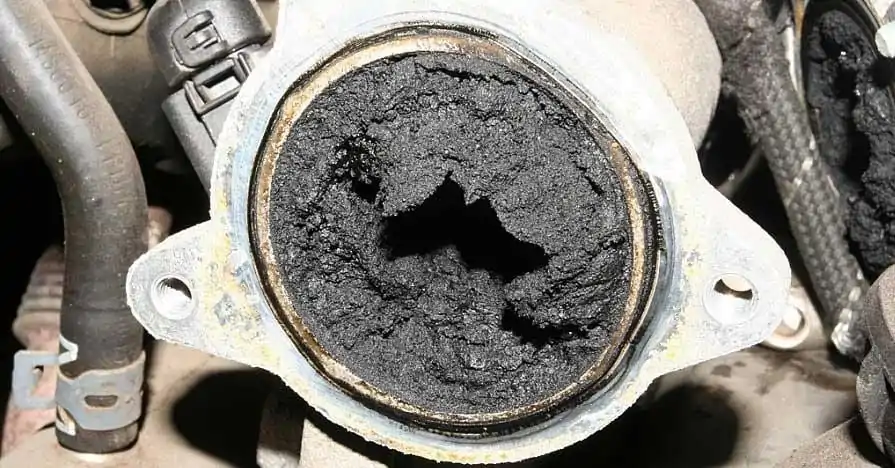
Of course, attention should be paid to the catalyst in such cases, if there is complete confidence that other systems of the car are in good working order. For example, in the event of a malfunction, the ignition, fuel and air supply systems can significantly reduce the above-mentioned auto indicators. Therefore, first of all, attention should be paid to the serviceability of these systems and the synchronization of their work.
A dead or close to this state of the catalyst can be the cause:
- Difficult starting of the motor, regardless of its temperature;
- Complete failure of the unit to start;
- The appearance of the smell of hydrogen sulfide in the exhaust gases;
- Rattling sound during engine operation (comes from the catalyst bulb);
- Arbitrary increase / decrease in engine speed.
When a catalyst malfunction appears in some car models, the "Check Engine" signal lights up on the tidy. This signal does not come on in all cases, since the machine does not use sensors that check the state of the cells in it. Data on the state of this part of the exhaust system is only indirect, because the sensors analyze the efficiency of the processes occurring in it (this function is performed by lambda probes). Gradual clogging is not detected in any way, so you should not rely on this indicator when determining the state of the device.
How to check - clogged catalyst or not
There are several ways to find out the state of the catalyst in the car. Some of the methods are simple, and you can diagnose yourself. If you are not sure that the work will be done correctly, this can be done at almost any service station for an appropriate fee.

Typically, catalyst failure is diagnosed by the absence of exhaust gas pressure or the presence of foreign particles in the device flask. "By eye" you can check if this converter is clogged by placing your hand under the exhaust pipe. If you feel that the exhaust is coming out at a certain pressure, then the catalyst is normal.
Of course, using this method it is impossible to determine the degree of wear, but if the part is on the verge of breakage or almost clogged, then this can be found out. More accurate parameters will be shown by the pressure gauge. The technical documentation for each car indicates what should be the pressure of the gases coming out of the exhaust pipe. For this, a pressure gauge is installed instead of a lambda probe located at the outlet of the flask.
Let's consider three more ways to diagnose a catalytic converter.
Visual inspection
Naturally, this procedure cannot be performed without dismantling the device. An impressive deformation of a metal bulb (a consequence of a strong impact) in almost 100% of the case means partial destruction of the cells of the filler. Depending on the degree of damage, it can affect the performance of the exhaust system. All this is individual, and the catalyst still needs to be removed to see how much the inside of the part is damaged.
A burned-out or clogged catalyst can be identified immediately after dismantling. Some of the cells will be missing in it, they will be melted or clogged with soot. You can also find out how badly the cells are clogged with a flashlight. It is turned on, brought to the inlet of the flask. If the light is not visible at the exit, then the part must be replaced. Also, if, after dismantling, small particles fell from the flask, you do not need to speculate: the ceramic filler fell. The amount of these particles will indicate the degree of damage.
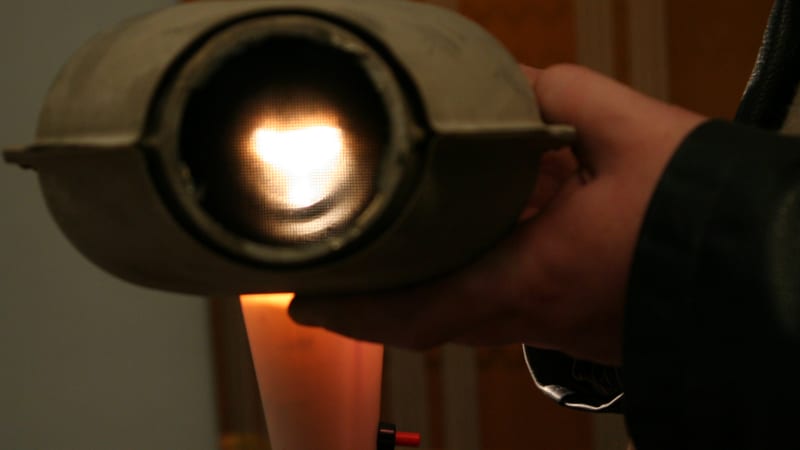
To remove the catalyst from the car, you need a pit or a lift. This makes it easier to access the device and more convenient to do the work than on a jacked-up machine. You also need to take into account that in different machines this part is removed in its own way. To find out the subtleties of the procedure, you need to clarify this in the instructions for the car.
Due to operation at high temperatures, the casing pipe retainer can become very sticky, and it will not be possible to remove it except with a grinder. Another difficulty associated with visual inspection of the part concerns the structural features of some modifications. In some cases, the flask is equipped with curved pipes on both sides, due to which the honeycomb is not visible. To check the passability of such models, other methods will have to be used.
How to determine if a catalyst is clogged or not using an infrared thermometer
When the first signs of a clogged catalyst appear (mentioned above, but the key one is a decrease in vehicle dynamics), to apply this method, the power unit and exhaust system should be properly warmed up. To do this, it is enough to drive a car for half an hour. Clarification: not just the engine must work, but the machine must move, that is, the unit has worked under load.
In this case, the catalyst should be warmed up above 400 degrees. After the ride, the car is jacked up and the engine starts again. An infrared thermometer can be useful in other cases, so it can be purchased for other measurements (for example, to measure heat loss in the house).
Measurements are made as follows. First, the laser of the device is directed to the pipe at the catalyst inlet and the indicator is recorded. Then the same procedure is carried out with the pipe at the outlet of the device. With a working neutralizer, the temperature readings between the inlet and outlet of the device will differ by approximately 30-50 degrees.
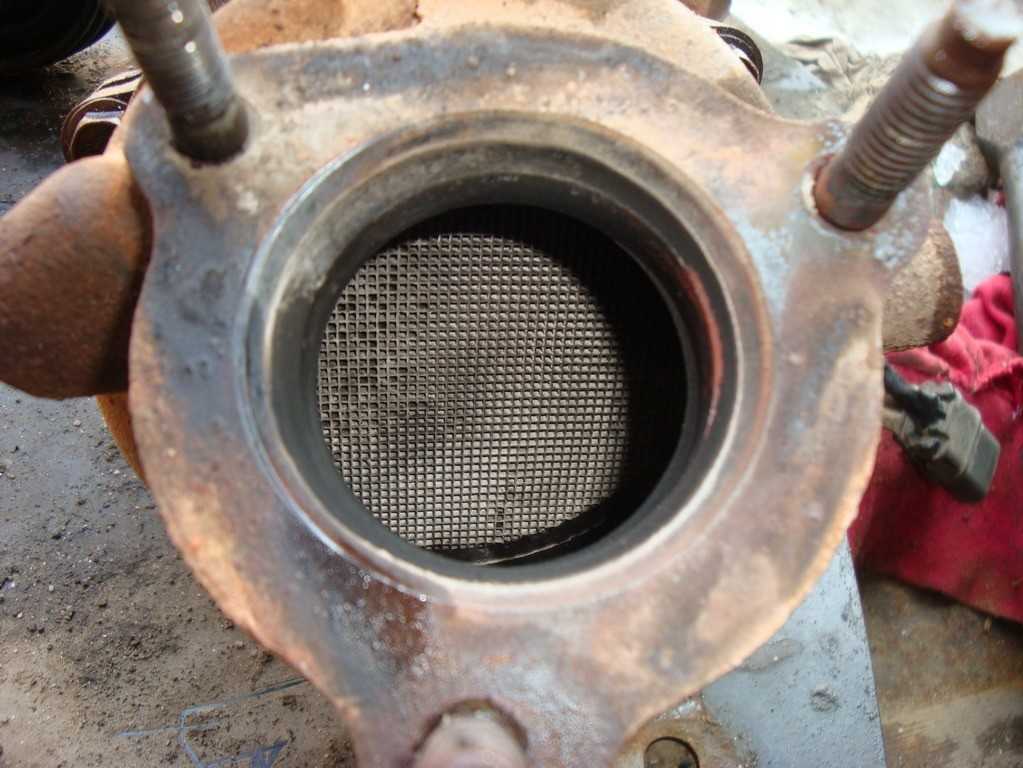
This small difference is due to the fact that chemical reactions occur inside the device, which are accompanied by the release of heat. But for any malfunctions, these indicators will differ more, and in some cases the temperature will be the same.
How to identify a clogged catalyst using a diagnostic adapter (autoscanner)
Similar temperature measurements in a heated catalyst can be made using an autoscanner. For example, you can use the ELM327 model. This is also a useful device that will come in handy for a motorist. It allows you to independently diagnose the machine, and check the performance of its systems and individual mechanisms.
To carry out the procedure on a new car, this scanner is connected to the OBD2 connector. If the car is an older model, then you will additionally need to purchase an adapter for the corresponding connector (most likely it will be a G12 contact chip).
Then the car starts up, the power unit and the catalyst heats up properly. To determine the condition of the catalyst, you need a smartphone with a suitable program to which two temperature sensors (B1S1 and B1S2) are added.
The catalyst is tested in the same way as with an infrared thermometer. The device heats up during a half hour drive. The only difference is that the indicators are analyzed by the program.
How to check the catalyst for clogging without removing
To make sure that the catalyst is malfunctioning without disconnecting it from the exhaust system, you can use two methods:
- Checking with an exhaust gas analyzer. This is complex equipment that connects to the exhaust pipe of the car. Electrical sensors analyze the composition of the exhaust gases and determine how efficient the catalyst is.
- Backpressure check. The advantage of this method is that it can be performed at home, and for diagnostics you do not need to purchase any special equipment, although there are ready-made kits for this procedure. The essence of diagnostics is to determine how much back pressure the catalyst creates in different engine operating modes. It is easier to carry out such a check if two oxygen sensors (lambda probes) are used in the exhaust system. The first sensor (standing in front of the catalyst) is unscrewed, and instead of it, a fitting with a tube is screwed in, at the other end of which a pressure gauge is installed. It is better that the fitting and tube are made of copper - this metal has the highest heat transfer rate, so it cools faster. If only one lambda probe is used in the car, then a hole of a suitable diameter is drilled in the pipe in front of the catalyst, and a thread is cut into it. At different engine speeds, the pressure gauge readings are recorded. Ideally, on a stock engine, the pressure gauge should be within 0.5 kgf / cc.

The disadvantage of the first method is that it is not available for residents of small towns due to the high cost of equipment (many service stations cannot afford to purchase it). The disadvantage of the second method is that in the absence of a lambda probe in front of the catalyst, it will be necessary to damage the pipe in front of it, and after the diagnosis, a suitable plug will need to be installed.
An independent test of the catalyst must be carried out on a moving vehicle. So the pressure gauge readings will be more plausible, taking into account the load on the motor.
Consequences of a clogged catalyst
Depending on the degree of clogging of the catalyst, soot can be removed from it. If you do not pay attention to the efficiency of the converter in time, then one day the car will simply stop starting. But at first, the motor will stall almost immediately after starting or work unstable.
One of the most neglected breakdowns is the melting of ceramic cells. In this case, the catalyst cannot be repaired, and no restoration work will help. In order for the engine to work in the same mode, the catalyst must be replaced. Some motorists install a flame arrester instead of this part, only in this case, for the correct operation of the control unit, it is necessary to upgrade the software. So the ECU will not fix errors due to incorrect readings of the lambda probes.
If the catalyst filler has deteriorated, debris in the exhaust system can seriously damage the engine. In some cars, it happened so that particles of ceramics got into the engine. Because of this, the cylinder-piston group fails, and the driver will have to, in addition to repairing the exhaust system, also perform the engine capital.
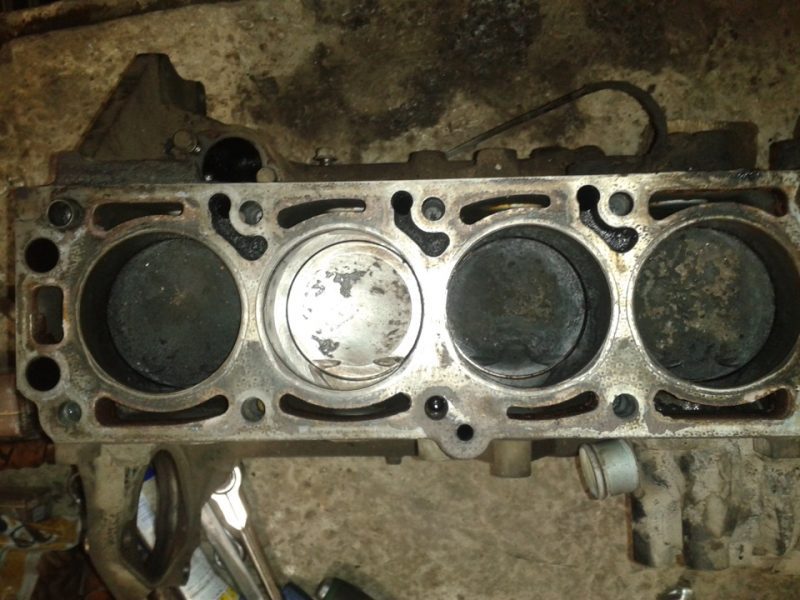
But, as we said earlier, a drop in engine power and car dynamics are not always associated with a faulty catalyst. This may be the result of incorrect operation or failure of a certain auto system. For this reason, when the symptoms mentioned above appear, a complete diagnosis of the vehicle should be carried out. About how this procedure takes place, and also how it can help, read in another article.
How does a clogged catalyst affect engine performance?
Since the exhaust gases must leave the engine freely during engine operation, the catalyst must not create a large back pressure for this process. It is impossible to completely eliminate this effect, because the exhaust gases pass through the small cells of the converter.
If the catalyst becomes clogged, this primarily affects the nature of the operation of the power unit. For example, at the time of starting the internal combustion engine, the cylinders are poorly ventilated, which leads to their poor filling with a fresh air-fuel mixture. For this reason, with a faulty catalytic converter, the car may not start (or stall immediately after starting).
While driving, it is felt that the motor has lost some of the power, which leads to poor acceleration dynamics. With a clogged catalyst, fuel consumption increases due to poor carburetion and the need to press the accelerator pedal harder.
Oil consumption with clogged catalyst
When the oil scraper rings wear out in the engine, oil enters the air-fuel mixture. It does not burn completely, which is why plaque appears on the walls of the catalyst cells. At first, this is accompanied by blue smoke from the exhaust pipe. Subsequently, plaque on the cells of the converter increases, gradually blocking the passage of exhaust gases into the pipe. Therefore, oil consumption is the cause of a clogged converter, and not vice versa.
What if the catalyst is clogged?
If in the process of checking the car it was found that the catalyst is faulty, then there are three options for solving this problem:
- The simplest thing in this case is to remove the part and install a flame arrester instead. As already mentioned, so that after such a replacement the car electronics does not register a large number of errors, it will be necessary to correct the ECU settings. But if the car must meet environmental standards, then the service that controls this parameter will certainly issue a fine for such a modernization of the exhaust system.
- Depending on the degree of contamination, the catalyst can be recovered. We will talk about this procedure in more detail.
- The most expensive procedure is replacing the device with a similar one. Depending on the car model, such repairs will cost from $ 120 and more.
How to Repair a Clogged Catalyst
This procedure makes sense only in the initial stages of clogging. In the stores that sell auto chemical goods, you can find different means for removing soot from the catalyst cells. The packaging of such products indicates how to use them correctly.

Mechanical damage, as a result of which the ceramic filler fell, cannot be repaired in any way. There are no replaceable cartridges for this part, so it makes no sense to open the flask with a grinder and try to find an identical filler at auto disassembly.
The same can be said about those cases when, due to improper operation of the fuel system and ignition, fuel is burned in the catalyst. As a result of the critically high temperatures, the cells melt and to some extent block the free removal of exhaust gases. No catalyst cleaner or rinse will help in this case.
What does the repair include?
It is impossible to repair a clogged converter. The reason is that the soot gradually hardens strongly and cannot be removed. The maximum that can be done is preventive flushing of the cells, but such a procedure has its effect only in the early stages of clogging, which is very difficult to diagnose.
Some motorists drill small holes in clogged combs. So they clear the way for the removal of exhaust gases. But in this case, the neutralization of toxic gases does not occur (they must come into contact with precious metals, and those are completely closed due to soot and a chemical reaction does not occur).
As an alternative to replacing the catalyst, some service stations offer to install a "trick" in the form of the same flask, only without a reel. To prevent oxygen sensors from provoking an error in the control unit, the “brains” of the machine are flashed, and flame arresters are installed instead of neutralizer cells.
The ideal option for repairing a clogged catalyst is to replace it with a new analogue. The key disadvantage of this method is the high cost of the part itself.
Catalytic converter replacement
This procedure, depending on the operating conditions, can be carried out after about 200 thousand kilometers of the car's mileage. This is the most expensive solution to the problem with a clogged exhaust system element. The high cost of this part is due to the fact that not many companies are engaged in the production of such equipment.
Due to imports to different countries, such products are expensive. Plus, the device uses expensive materials. These factors contribute to the fact that original catalysts are expensive.
If a decision is made to install an original spare part, then in this case there will be no need to interfere with the settings of the auto control unit. This will preserve the factory settings of the machine software, due to which it will comply with environmental standards, and the motor will serve its intended resource.

Since it is quite expensive to return the car to the factory settings, many motorists are forced to look for alternative options. One of them is the installation of a universal catalyst. This can be an option that fits most car models, or a replacement cartridge designed to be installed in place of the factory filler.
In the second case, the work is not worth the material investment, although it can save the situation for a while. Such a catalyst will work for approximately 60 to 90 thousand kilometers. But there are very few services that can perform such an upgrade. Plus it won't be a factory option because, as we said earlier, auto parts manufacturers don't create replacement cartridges.
It is cheaper to install a flame arrester. If this part is installed instead of the standard equipment, then such a replacement is easy to recognize, and if the machine is subject to a technical inspection, then it will not pass the check. The installation of an internal flame arrester (placed in an empty catalyst) will help to hide such an upgrade, but the exhaust composition sensors will certainly indicate a discrepancy with standard indicators.
So, whichever method of catalyst replacement is chosen, it is only if the factory version is installed that the car can be expected to meet the standard parameters.
Consequences if the catalyst is not repaired
Almost any engine paired with an exhaust system equipped with a catalyst can quickly fail if the converter becomes clogged, and the driver ignores the obvious signs of such a malfunction.
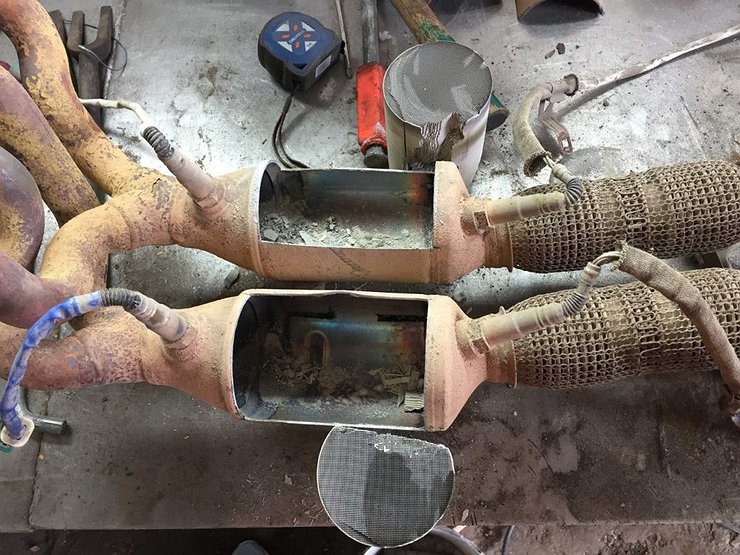
At best, a clogged exhaust system element will prevent the engine from starting. Worse, if small particles of scattered honeycombs get into the cylinders. So they will act as an abrasive and damage the cylinder mirror, which will subsequently lead to a major overhaul of the motor.
Can you drive with a clogged catalytic converter?
If the catalytic converter is slightly clogged, the car can still be operated, and the driver may not even notice the problem. Even if the dynamics of the car will decrease by a couple of percent, and fuel consumption will also increase slightly, few will sound the alarm.
A significant drop in power will make driving such a transport unbearable - you will need to bring the engine almost to maximum speed in order to switch to a higher gear, and when fully loaded, the car will completely become slower than horse-drawn vehicles. In addition, a damaged catalyst can cause a quick failure of the engine.
Is it necessary to carry out maintenance of the catalyst in a timely manner?
Regardless of where the catalytic converter is installed, it will still consist of chemically active cells, which will clog up sooner or later during the operation of the device. The quality of the fuel, the settings of the fuel system and ignition - all this affects the service life of the part, but it will not be possible to completely eliminate the clogging of the cells.
If we talk about the prevention of catalyst clogging, then it makes sense to carry out a similar procedure. In this case, the service life of this element will be 10 years or more. Changes in the operation of the lambda probe may indicate problems with the catalyst, which can be found out during routine computer diagnostics of the control unit.
If even the slightest errors appear in the operation of the power unit, this may be due to the fact that the control unit is trying to adapt its operation to the changed values of the lambda probe at the outlet of the catalyst. It is worth recalling that flushing the device only makes sense in the early stages of clogging. To do this, you need to purchase a special tool that can be found in a store with auto chemicals.
But not every remedy gives the desired result. Before purchasing such a product, you should clarify how it works. Here is a short video on whether it is possible to clean the catalyst without removing it from the car:
Related videos
Here is a detailed video on checking the catalytic converter:


Watch this video on YouTube
Questions and answers:
What if the catalyst is clogged? If the catalyst becomes clogged, then it is not repaired. In this case, it is either changed to a new one or deleted. In the second case, all the insides (clogged honeycombs) are removed from the flask, and the firmware of the control unit is also corrected so that it does not register errors from lambda probes. Another option is to install a flame arrester instead of a catalyst. In this case, this element makes the operation of the internal combustion engine softer and more responsive, but at the same time the service life of the exhaust system is somewhat reduced.
How to check yourself if the catalyst is clogged? A common symptom of a clogged catalytic converter is knocking during acceleration (feeling like rubble has appeared in the can of catalyst). Visually, the problem can be detected after intense driving. Stopping the car and looking under it, you can find that the catalyst is hot. If such an effect is found, it means that the device will soon fail. When the car starts up after a long period of inactivity (the internal combustion engine has cooled down completely), the problem of a clogged catalyst manifests itself in a pungent and pungent smell from the exhaust. By means of equipment, the catalyst is checked for compliance with the exhaust gas pressure in the area of \ uXNUMXb \ uXNUMXbthe lambda probe. The rest of the methods involve the use of special equipment and computer diagnostics.

16 comments
anonym
Is it possible that the car turns off after starting is it due to the clogged catalyst
Muha Bogdan
This is how I suffer many times, it starts and stops, and does not fire, I changed the spark plugs, coils, filters, checked the flow meter all right, but I have no light bulb on board, and no error on the tester, when I start in the morning it smells ugly to the exhaust, can be the catalyst - the car is e46,105kw, gasoline
Algattone 101
I have a new 1.2 12v turbo petrol, it doesn't go up more than 3000 rpm in neutral and more than 2000 rpm in gear, and it almost smells like sulfur at the beginning .. Could it be the catalyst?
Florin
A diesel engine may not start if the catalyst is clogged
anonym
Or this problem I too, reading or appreciated the problem, or a gas car and thanks to the comment I will provide. Or understood that all this corresponds. The car starts badly, it consumes me a lot, often does not start at all.
George
I have a chebrolet sprint from 85 and when I turn it on, it goes and changes the spares, the helmet of the inision and continues with the fayo
anonym
Hello,
I have a 2012 Tucson type vehicle, I have recurring lockouts! 16 times the scanner analysis shows negative results, i.e. zero defects. Stalls are common when I drive in 2, 3 and sometimes 4 speed, especially when the climate is hot and the path is uphill! extensively inside the tunnels!
anonym
I have a golf 5 1.9 tdi after a journey of 30 km, the power of the engine starts to decrease with trembling in the whole car and it does not help me in overtaking...in sc
Maxim
Hi, look forward to Civic 2005 the signal to Obd2 detects me completely blocked catalytic converter (3 of 3) the car on heats constantly has report I have tried everything thermostat remove replace prestone etc I have mass heat coming out of the chaufrete everything and correct a given moment of form a mega pressure and spits by overflo and by another place completely the other side below thank you there I give up ✌️
anonym
My bike had a catalyst and I didn't even know it. As there is no way to keep replacing it, I had the exhaust cut off, ripped off the catalytic converter and soldered again. It was clogged, slowing down the performance a lot. After that, it improved a lot.
Roger Pettersson
Hi
Has a MB with v8 so two catalysts one has the same color as when I mounted it the other is golden brown. Have driven with a broken lamb probe. Do you think the golden brown cat is fucked ???
Regards Roger
Mark
Catalyst error, change catalytic for a new one and after two weeks I have this error again. What can be?
Marcio Correa Fonseca
A Mondeo 97 vehicle, the same is reddening, the egr tube may be a clogged catalyst, the same vehicle burns the head gasket constantly
Sadik Karaarslan
My Mrb vehicle is 2012 model Isuzu 3D. N series. The vehicle is constantly opening a manual catalyst, it may cause 3 or 4 times a day for communication 05433108606
Mihai
I have a vw passat, I stopped normally as it stops and when I had to start it again to go on the road it didn't start, but instead one of the lights came on flashing when I start it, a car with a key underneath appears .The engine shows signs that it would like to start but it doesn't start, the witness appears, which may be the cause, I'm really waiting for an answer, please ??
dusko
Is it possible for the Ugadi car to be detected while driving before starting for overtaking, due to a clogged catalyst.